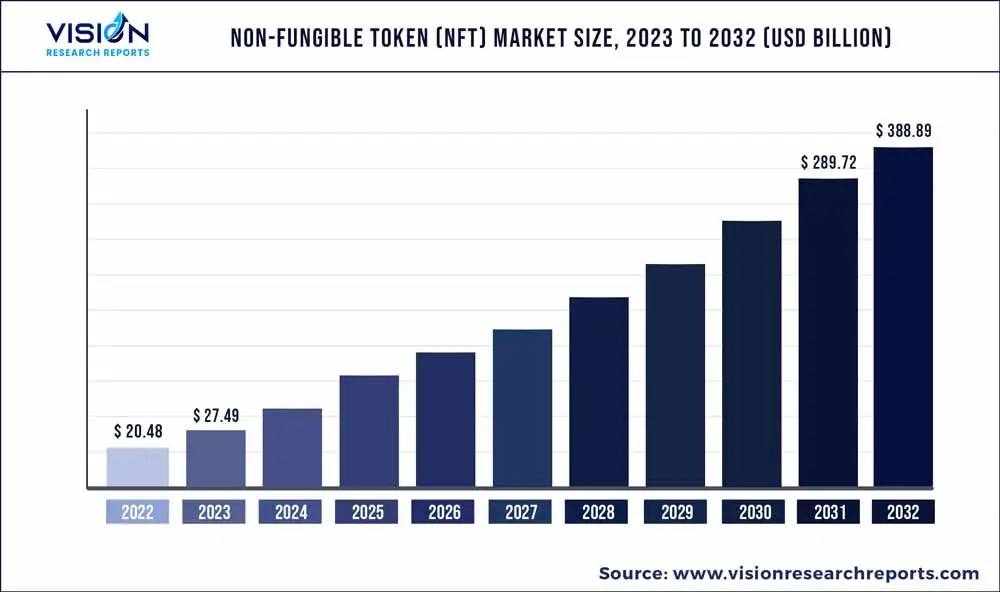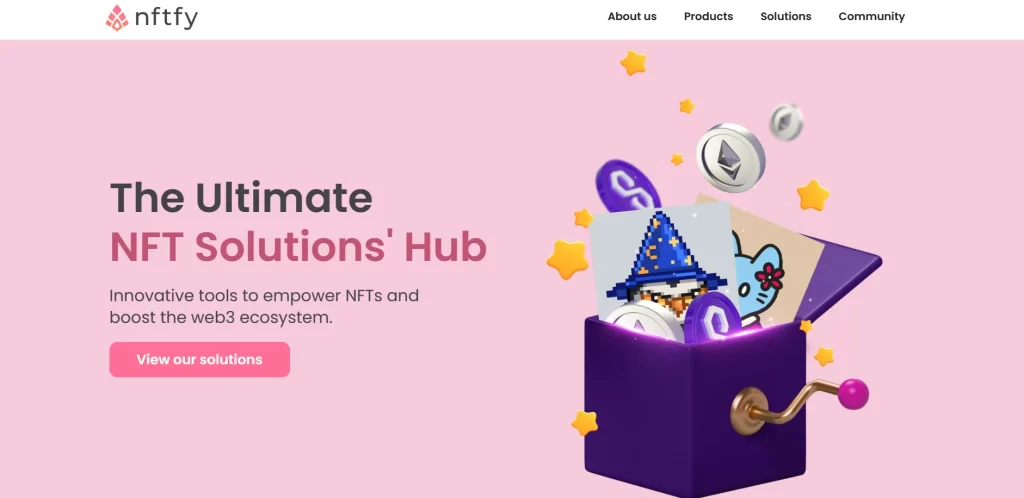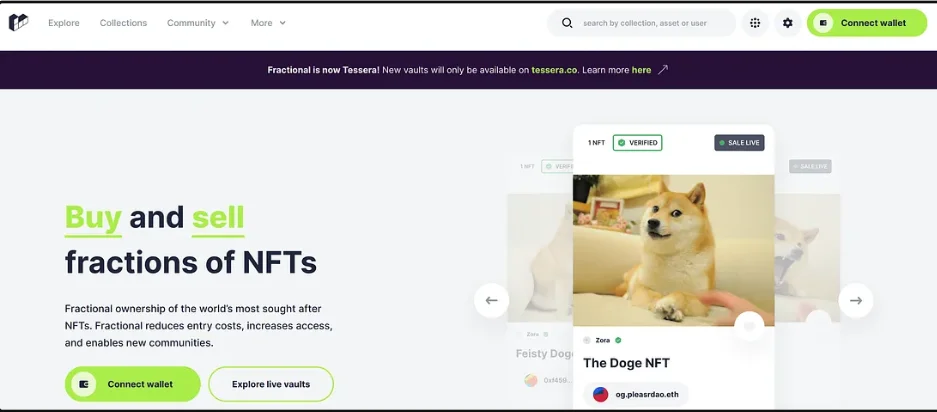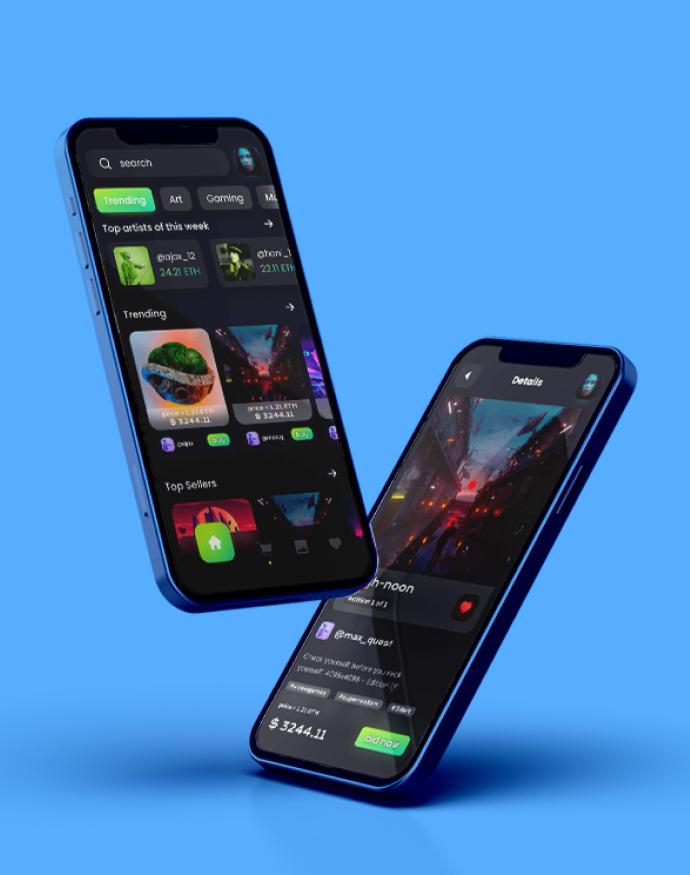Have you ever stumbled upon a piece of digital art or a collectible online that you wished to own a part of, but the price tag made your wallet weep? Well, the evolving world of blockchain and digital assets has a solution for you: Fractional NFTs.
Imagine slicing a digital Mona Lisa into several pieces, each holding a fraction of the art’s value and charm. This isn’t just about art; it’s a revolution across various asset classes, making the inaccessible, accessible. Let’s dive into the kaleidoscopic world of Fractional NFTs, exploring its workings, benefits, and multifarious use cases.
Understand the technical aspects of fractional NFTs, exploring their core functionalities, use cases, and the potential business opportunities they present.
NFT Key Market Takeaway

Source: Visionresearchreports.com
The surging popularity of digital art has fueled the NFT market’s impressive growth. The growing trend is further amplified by the global fascination with NFTs, driven by their unique properties like transparency and scarcity.
The growing interest in owning digital assets and the desire for distinct digital identities have significantly contributed to this market’s expansion.
By exploring other possibilities with NFTs, businesses can benefit in various ways, such as by developing their fractional NFT marketplace or implementing applications to their operations.
What Is A Fractional NFT?
Fractional NFTs, or fNFTs, break down the ownership of an NFT into smaller, more affordable pieces. This division transforms a traditionally singular and potentially expensive investment into a collective and accessible opportunity.
At its core, the process involves dividing the NFT into several parts, each represented by its own token, maintaining the integrity of ownership and value distribution. These tokens can then be traded or sold individually, offering a slice of the original NFT’s ownership and benefits.
While fractional NFTs were originally used for digital art, they can be applied to other types of NFTs as well. For example, imagine a fractionalized NFT representing ownership in a piece of virtual real estate or a rare collectible.
F-NFTs offer a new way to invest in digital assets and make them more accessible to a broader audience.
How Do Fractional NFTs work?
The process of creating fractional NFTs involves dividing a single NFT into multiple smaller fractions or shares, which different individuals can then own. This division doesn’t dilute the value of the original asset; instead, it creates a new way for people to invest in and own a part of something they value. Here’s a step-by-step breakdown:
Tokenization:
The original NFT, which could be anything from digital art to a piece of real estate represented digitally, is tokenized into several smaller units. This process is facilitated by smart contracts on a blockchain platform that supports NFTs, such as Ethereum.
Issuing Fractional Tokens:
These smaller units are then issued as separate tokens themselves, often on the same blockchain. Each token represents a share of the original NFT, and the total value of all fractional tokens combined reflects the value of the original asset.
Ownership and Trading:
Individuals can buy, sell, or trade these fractional tokens in a manner similar to trading stocks or cryptocurrencies. Ownership of these tokens is recorded on the blockchain, ensuring transparency and security.
Rights and Governance:
Fractional NFT owners may have rights associated with their fractional ownership, such as voting on the future of the NFT (e.g., whether to sell the original asset at a certain price) or receiving a portion of any revenue generated by the asset.
Use Cases Of Fractional NFTs
Fractional ownership NFTs unlock a variety of applications that capitalize on the benefits of shared digital ownership. Let’s explore some key use cases:
1. Art and Collectibles
Fractional ownership via NFTs allows art lovers to own portions of high-value artworks or collectibles jointly. This democratizes access to prestigious pieces, fostering shared enjoyment and investment potential for a broader audience.
2. Metaverse
Premium virtual land in the metaverse can be extremely expensive. F-NFTs allow users to co-own parcels of virtual land, granting them shared access and potential revenue streams from the land’s development. Co-ownership can be applied to virtual buildings, rare in-game items, or even digital fashion accessories.
3. Real Estate
By tokenizing real estate properties with fractional NFTs, investors can hold fractional interests in these assets. Tokenization promotes portfolio diversification and grants access to the real estate market without a specific upfront capital requirement.
4. Intellectual Property
Creators can leverage fractionalization for their intellectual property, including music, films, and patents. Leveraging fractionalization enables investors to own fractions of the associated rights and potential revenue streams, providing creators with funding while presenting investment opportunities.
5. Luxury Goods and Fashion
Fractional ownership NFTs open doors for shared ownership of luxury items like high-end fashion accessories or rare goods. Shared ownership allows individuals to hold fractional ownership of exclusive items, creating avenues for investment and access to coveted products.
6. Sports and Memorabilia
The fractional NFT marketplace empowers sports fans to own fractions of sports memorabilia, athlete endorsements, or even shares in sports teams. Owning a fraction of sports memorabilia fosters deeper fan engagement and offers opportunities for fans to benefit from the value appreciation of sports-related assets.
The Need For Fractionalization In NFTs
Fractionalization unlocks a fascinating array of benefits by offering a compelling solution and democratizing access to these digital assets by breaking them down into smaller and more affordable pieces.
Firstly, fractionalization dismantles the cost barrier, allowing a wider audience to participate in the NFT market. By dividing ownership into fractions, even high-value NFTs become accessible to a bigger pool of potential buyers.
Secondly, the value of individual fractions remains independent. If a fractional owner chooses to sell their share at a reduced price, it won’t impact the value held by other stakeholders in the NFT.
Thirdly, even as an NFT’s overall price tag climbs during an auction, fractionalization ensures continued buyer interest at lower price points. This allows a new wave of participants to enter the game, even when the complete NFT becomes out of reach.
Advantages Of Fractionalizing NFTs
Fractional NFTs offer several benefits that go beyond just unlocking new ownership models for digital assets. By dividing an NFT into smaller fractions, individual pieces become more affordable and easier to trade. Here are the benefits offered by fractional NFTs
1. Better price discovery
In the world of NFTs, determining a fair price can be challenging, especially for new creations or those needing a sales history. This is where Fractional NFTs (F-NFTs) come in and offer a solution for efficient price discovery. By dividing an NFT into smaller pieces, these fractions can be bought and sold on the market.
2. Curator’s rewards
When an NFT owner decides to fractionalize their asset on a chosen marketplace, they can earn a curator fee. This fee is a percentage of the trading value of those fractions. While the owner has the control to set and adjust this fee amount, there’s a maximum limit in place to prevent excessively high fees.
3. Minimized Ownership Costs
Owning a fraction of an asset spreads the costs of maintaining and transacting among multiple owners, making it significantly cheaper than single individual ownership. From storage and licensing fees to buying and selling expenses, everything is divided proportionally, keeping fractional ownership an affordable option in the long run.
4. High liquidity
Rare NFTs are valuable, but their exclusivity can make them hard to sell. Fractional NFTs (F-NFTs) address this lack of liquidity by letting smaller investors co-own these assets. Essentially, F-NFTs make expensive NFTs more saleable by dividing them into smaller, more affordable pieces. This fractionalization not only attracts new investors to the NFT market but also directly tackles the issue of limited liquidity.
5. Financial Innovation
The world of finance is undergoing a revolution with the emergence of great financial instruments. These instruments are unlocking entirely new strategies for deploying capital. Complex derivatives and futures contracts are empowering investors with a great level of precision.
What Is Reconstitution, And How Is It One Of The Biggest Challenges For Fractional NFTs?
While fractionalizing high-value, unique, or rare NFTs offers a lucrative opportunity for owners to unlock profits by selling smaller portions, a significant hurdle arises the difficulty of reacquiring all the fractions to reunite the complete NFT.
Let’s illustrate this challenge with a familiar example. Imagine selling a quarter slice of a cake. The remaining three-quarters can still be enjoyed or sold independently. Similarly, if you sell 25% of your company, the remaining 75% retains its value and functionality. In these scenarios, the utility of individual fractions is independent of the whole.
However, fractional ownership with NFTs operates differently. Owning and trading an NFT in its entirety is far more convenient than dealing with fragmented pieces. Owning the whole NFT grants complete control – you can freely sell it at any time or utilize it for its intended purpose.
This may be different for someone who owns a fraction of a valuable in-game asset. The fragmented ownership might restrict them from using the asset within the game as originally intended.
The only path to regaining complete control of the NFT is to reacquire all the sold fractions from their owners. This process can be fraught with complexity. Owners might be unwilling to resell their fractions, or you might lose access to the private keys needed to claim your ownership rights. In such scenarios, reconstituting the NFT becomes virtually impossible.
Fortunately, advancements are being made to address this challenge. Fractionalization protocols have been developed to facilitate the process of reconstituting NFTs through a mechanism called buyout auctions.
Buyout auctions provide a structured framework for original NFT owners to repurchase the sold fractions, ultimately enabling them to reunite the complete NFT. Let’s understand more about buyout auctions in detail.
What Is A Buyout Auction And How Does It Solve The Reconstitution Challenge?
Just like a regular auction, a buyout auction involves trading, but instead of physical items, it deals with F-NFTs. When an NFT owner splits their asset into fractions (fractionalizes), they establish a minimum price, called the reserve price, for the complete NFT. This reserve price is the lowest amount they’d accept in an auction for the NFT.
Existing F-NFT holders have the option to keep their ownership portions. However, to prevent the sale to a new buyer, they’ll need to outbid that buyer’s offer. If they’re outbid, all the individual fractions automatically combine to reform the complete NFT, which is then transferred to the winning bidder. This buyout option helps determine the NFT’s fair market value, ultimately boosting its overall value.
Examples Of Top Fractionalized NFTs
Ethereum, a popular cryptocurrency platform, just launched a new system called ERC-404. This system allows people to co-own NFTs instead of just one person owning the entire thing. This new way of owning NFTs is already creating a lot of excitement, with some record-breaking sales. Let’s see some specific examples of how this is changing things!
1. CryptoPunks
Remember those super expensive digital pictures called CryptoPunks that sold for millions? Well, owning a tiny piece of one of those is now possible for just a few cents! This is because something called fractionalization broke 50 of the CryptoPunks into 250 million tiny pieces called “uPunks” in April 2022.
2. Grimes’ Art
Canadian singer Grimes sold very expensive digital art in 2021. To make her art more affordable, she broke some of the artwork into 100 smaller pieces and sold each piece for only $20. This allowed more fans to own a part of her art.
3. Mutant Cats
The Mutant Cats is an NFT collector’s club where members, identified by their Mutant Cat NFTs, work together. This club, a DAO (Decentralized Autonomous Organization), pools resources to buy famous NFTs like Cool Cats and Bored Apes. Membership comes with perks: a share of ownership in these valuable NFTs (like slices of a pie!), special $FISH tokens that act like mini-shares, access to a members-only community, and even exclusive free NFTs!
4. Doge Meme Token
Dogecoin wasn’t just a viral sensation – it became a million (well, billion) dollar asset. In 2021, it sold as a non-fungible token (NFT) for $4 million. But the story takes an interesting turn. The owner, PleasrDAO, decided to break the mold by fractionalizing the NFT into a staggering 17 billion pieces. Each piece was called a $DOG token.
These are just a few examples of exciting ways fractional NFTs are revolutionizing the industry. By breaking down high-value NFTs into smaller, more affordable pieces, fractionalization allows a wider audience to participate. This opens up a new world of possibilities for investment and fosters a stronger sense of community ownership.
Popular Fractional NFT Marketplaces
The exciting world of fractional NFTs is booming, and each marketplace comes with its own set of features and advantages. Let’s explore some of the popular Fractional NFT Marketplaces for business ideas and inspirations:
1. KuCoin

KuCoin caused a stir recently with the launch of hiBAYC, a project that lets investors own a fraction of a coveted Bored Ape Yacht Club NFT. This platform utilizes ERC-20 tokens to facilitate fractional ownership and boasts attractive features like guaranteed liquidity reserves and a user-friendly redemption process.
2. Public

By integrating with Otis, Public.com has taken the lead in the world of investment, allowing the platform to be the first platform where investors can construct a diversified portfolio encompassing stocks, cryptocurrencies, and the alternative investments that Otis offers.
3. Unicly

Unicly shakes up the world of NFTs by offering a revolutionary platform for fractionalization and trading. Users can turn their NFT collections into tradable assets with guaranteed liquidity. It achieves this by merging the income-generating features of DeFi (decentralized finance) with NFT tokenization. This unique combination creates exciting opportunities for collectors, investors, and even creators.
4. Fractional.art

Fractional.art prioritizes ease of use with an intuitive interface, while robust security features like two-factor authentication and multiple risk management tools ensure peace of mind. Additionally, a range of liquidity options empowers you to optimize your investments within the platform.
Conclusion
Imagine if instead of only one person being able to afford a super expensive piece of digital art, it could be cut up into smaller pieces, like shares of a company. This is what NFT fractionalization is all about.
Breaking down the ownership of an NFT into smaller chunks makes them more affordable for a wider range of people to invest in. As the popularity of NFTs keeps growing, we can expect even more developments in this area.
In addition to increasing accessibility and liquidity, NFT fractionalization opens doors for new financial opportunities. Imagine a rare collectible that appreciates in value over time. Fractionalized NFTs can also be used for community ownership of digital assets, enabling decentralized decision-making about their use and future.
How Can We Help in Developing a Fractional NFT Marketplace?
The rise of non-fungible tokens (NFTs) has ushered in a new dawn for digital ownership and investment opportunities. At IdeaUsher, we recognize the potential locked within NFTs and, more specifically, the revolutionary concept of fractional NFTs. These assets promise not only to democratize access to high-value digital and physical assets but also to inject unparalleled liquidity and community engagement into the digital marketplace.
Together, we can unlock the true potential of fractional NFTs, creating a marketplace that is not only a hub of digital assets but also a beacon of innovation and community engagement.
Hire ex-FANG developers, with combined 50000+ coding hours experience




FAQ
Q. What is a fractionalized NFT?
A. Fractional NFTs allow for the partition of a single, unique NFT into several interchangeable pieces. These units, or fractions, are represented as ERC-20 tokens, with each representing a stake in the original NFT.
Q. What is fractional ownership via NFT?
A. Fractional NFT ownership is the division of a single non-fungible token (NFT) into smaller, marketable portions. Each fraction is a piece of the original NFT, allowing numerous investors to have a share in the asset.
Q. What are the benefits of NFT fractionalization?
A. Fractional NFTs, which digitally reflect physical property assets, allow investors to buy and sell real estate. Commercial and residential buildings may be split into tokens representing varying percentages of ownership, making real estate investing more accessible.













